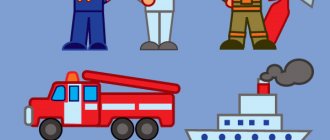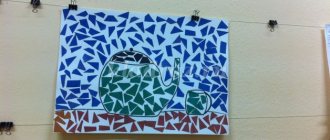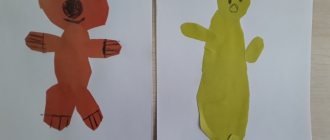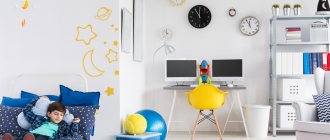Progress of the lesson
Organizing time.
— Guys, today guests (preschool teachers) came to our lesson. To get them to know you, now each of you will loudly say your name and say how many syllables it has.
Children say their names and determine the number of syllables in them. (For example: “My name is Misha, my name has 2 syllables”).
Riddles about toys.
- Now try to guess who else came to visit you.
(The speech therapist asks riddles):
“Drinks gasoline like milk, can run far. Carries goods and people. You know her, of course?” (Car).
“This funny animal is made of plush. There are paws, there are ears. Give the beast some honey and make a den for it.” (Teddy bear).
"What does all of this mean? My daughter is not crying. If you put him to bed, he’ll sleep for a day, or two, or even five.” (Doll).
“If you hit the wall, I’ll jump back. If you throw it on the ground, I’ll jump.” I’m flying from palm to palm – I don’t want to lie still!” (Ball).
“I received these miracle bricks as a gift. Whatever I put together, I break, I start all over again.” (Cubes).
(After each guessed riddle, the corresponding toy is taken out from behind the screen).
- Guys, tell me in one word, who else came to visit us?
(Toys).
- What are toys for?
(Children's answers)
Formation of possessive adjectives:
— What can toys be made from?
(Ball game)
Wood cubes (which ones?) - wooden Rubber ball (which ones?) - rubber Plush bear (which ones?) - plush Mice made of fur (which ones?) - fur A straw doll (which ones?) - straw An iron bucket (which ones?) ?) – iron Plastic pyramid (which one?) – plastic
Surprise moment.
— Here's another riddle: "What is this?"
(A pyramid without rings is brought in).
— Guys, do you know why the pyramid has no rings? Now I'll tell you: the greedy Hippo
(showing the corresponding toy)
took all our rings and doesn’t want to give them back. He agreed to give the rings only if you complete all his tasks. For each task - one ring. Do you agree?
Isolation of the first sound from words, characteristics of this sound.
Behemoth's first task:
- You must determine the first sound in the name of the toys and stick the corresponding sound - a circle on the flannelgraph.
(“
Dump
truck
,
bear ,
killer,
donkey
,
bunny
,
pyramid
,
robot
”).
(A vowel sound is a red circle; a hard consonant is a black circle; a soft consonant is a blue circle).
Finger gymnastics. (Development of fine motor skills of hands)
“On a large sofa, Katina’s dolls are sitting in a row: Two bears, Pinocchio, And cheerful Cipollino, And a kitten, and a baby elephant. One two three four five. Let’s help our Katya count the toys.”
Sound analysis.
Next task: perform a sound analysis of the kitten's name - VASKA.
(Children perform sound analysis using sound rulers and pencil cases).
One child completes the task at the board using the “sound cubes” manual and draws a syllable diagram of the word on the board.
Phonemic synthesis.
Game "Live sounds".
Children choose circles with symbols of sounds: [z], [a], [y], [k], [a], stand in a given order and pronounce “their” sound.
Dynamic pause.
A) “My ball” (coordination of speech with movement):
“My cheerful friend, my ball, Everywhere, everywhere he is with me. One two three four five. It’s good to play with the ball” (V.Volina)
B) “Ball”:
(The speech therapist “inflates” the balloons: the children stand up, pronouncing the sound for a long time: “ssss...”.
Then the balls are “pierced”: the children slowly squat, pronouncing the sound: “sh-sh-sh...”).
Compiling a story based on a series of plot pictures.
Game "TV".
On the typesetting canvas is a story compiled from a series of plot pictures (“Boat”). The two pictures are mixed up. Children must establish the correct sequence. Then all the pictures (one by one) are inserted into the “TV” manual.
- Children, now we will watch an interesting cartoon. But here's the problem: the sound broke. We need to choose a speaker who will voice our cartoon.
(The speaker is selected by a rhyme that all children recite:
“We play with the sound [sh]. We select word by word: “hat, fur coat, wardrobe, badge! Get out of the circle!").
Before starting to “voice” the cartoon, the child must explain why the word “token” turned out to be superfluous.
MAGAZINE Preschooler.RF
Lesson summary for senior preschool children “My toys”MBDOU "DS OV No. 8"
Usinsk
Goal: to cultivate a caring and friendly attitude towards toys.
Tasks:
- expand a child’s horizons through playing with toys;
- cultivate a caring attitude towards things;
- cultivate the ability to value friendship and loyalty.
Material: musical arrangement; many different toys for the game “Shop”
;
story by N. Kalinina “Is this how they play?”
;
poems by A. Barto “Toys”
; colored pencils according to the number of children; A-4 sheets of paper for each child.
Progress of the lesson.
Children enter the group and stand in a circle on the carpet. The music sounds "Hey, hey, hello to you!"
(greet each other)
. They sit on the carpet in a circle.
Educator: Today we will talk about toys. Oh, guys, look, who is that lying under our bench? They find a wet hare. Reading the poem by A. Barto “Bunny”
:
The owner abandoned the bunny. The bunny was left in the rain. I couldn’t get off the bench - I was completely wet.
Educator: Guys, do you feel sorry for the toy hare? (children's answers)
.
Educator: Did the girl who owned the toy do the right thing by leaving the bunny to get wet in the rain? (children's answers)
.
Educator: Guys, look, I think I see someone.
(They find a bear with a torn paw.)
Reading the poem “Bear” by A. Barto:
They dropped the bear on the floor and tore off the bear's paw. I won’t leave him anyway, because he’s good.
Educator: And in this poem does the child love his toy? (children's answers)
Yes, guys, you shouldn’t treat your toys badly, even if something breaks or comes off for some reason. Sometimes you just need to replace or repair a part and the toy will be the same again
Educator: Guys, do you like toys?
Children: Yes.
Educator: Do you have any favorites?
Children: Yes.
Educator: How do you feel about them? (Children's answers)
.
Educator: Now let's rest a little.
Physical school
Here is a big pyramid (reach up)
.
And a cheerful, ringing ball (jumping in place)
.
Soft bear with clubfoot (steps in place, on the outside of the foot)
.
Everyone lives in a big box (show big square)
.
But when I go to bed (hands under the cheek, close my eyes)
, everyone starts playing
(depict any movement)
.
Educator: Guys, I really want to read you a short story that N. Kalinina wrote, it’s called “Is this how they play?”
.
The teacher reads the story.
“Is this how they play?”
Sasha and Alyosha came to the younger group and approached the toys. And there are a lot of toys: there are bears, hares, dolls and doll dishes, and beds for dolls, there are cars, trucks and fire engines, there is a brown bear on a white horse. Everything is in the doll corner, there is a lot of everything.
Alyosha looks at everything and doesn’t know what toy to take or what to play with. But Sasha only looked at everything for one minute and immediately wanted to take everything.
He ran to the doll corner - a bear under his arm, a bunny in his pocket. And he takes the crib and pulls the dog towards him - he puts everything in one pile:
- Don’t touch, don’t take, I’m playing with toys.
The guys are standing there, surprised, looking at Vera Ivanovna.
That's it boy! Is this how they play?
Questions:
- What is this story about?
- What toys were in the doll corner?
- What was Alyosha doing?
- How did Sasha behave in the doll corner?
- What was he doing?
- What did he tell the children?
Educator: What would you do? (children's answers)
Educator: Guys, I have this question for you - where do you think toys come from? (from the shop)
. Do you want to go to a toy store?
Children: Yes!
Educator: Let's go there now and choose the toy you like, and you can play with it only after class.
But you won’t be able to just take the toy you like, because you have to pay for them in the store. And you will pay with your knowledge.
And so, let's go (the soundtrack of a children's song sounds)
.
Educator: Guys, we ended up in that same toy store. Look at them. I think you have already chosen something for yourself. But first, let's arrange the toys correctly in our store.
Game "Higher, lower, further, closer"
.
Educator: Finish the sentences I started.
The doll stands higher, and the car... (lower)
.
The matryoshka stands closer, and the cubes... (more)
.
A truck is larger, and a passenger car... (smaller)
.
A truck has a wider body, but a van... (narrower)
.
Educator: Great!
(Children help the teacher arrange the toys correctly.)
Educator: Now your attention, ingenuity and resourcefulness will be useful to you. You are ready? Listen to the assignments carefully. If you know the correct answer, raise your hand. If you answer correctly, you will have the opportunity to choose a toy.
Task 1. Come up with a sentence of three words.
Task 2. Call it affectionately: hare - ..., ball - ..., doll - ...
Task 3. Think of a word with the sound “sh”
was in the middle of a word.
Task 4. Where in the word “toys” is the sound [and]
?
Task 5. Come up with a sentence of two words.
Task 6. Think of a word with the sound “H”
was at the beginning of the word.
Task 7. Say the opposite: the squirrel is small, but the bear...
Task 8. How many letters are in the word “game”?
(After each answer, the child receives the toy he likes)
.
Educator: Well done! Each of you chose a toy to your liking. And I also want to buy a toy. Ask me any question, and I will try to answer it.
(One of the children asks a question - the teacher takes the toy)
.
Educator: Let's now put our toys on the chairs so that they can see how well you will work further, especially since we agreed to play with them after class.
Educator: Guys, let's imagine that we are artists and we will draw our favorite toys.
Children draw their favorite toys.
| Next > |








